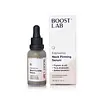What's inside
What's inside
 Key Ingredients
Key Ingredients

 Benefits
Benefits

 Concerns
Concerns

No concerns
 Ingredients Side-by-side
Ingredients Side-by-side

Loess Extract
Skin ConditioningCollagen Extract
Skin ConditioningPropanediol
SolventButylene Glycol
HumectantPentylene Glycol
Skin ConditioningGlycerin
HumectantLeontopodium Alpinum Callus Culture Extract
AntioxidantEragrostis Tef Seed Extract
EmollientRice Amino Acids
Skin ConditioningHydrolyzed Adansonia Digitata Seed Extract
Proline
Skin ConditioningHydrolyzed Vegetable Protein
Skin ConditioningXanthan Gum
EmulsifyingEthylhexylglycerin
Skin ConditioningPotassium Sorbate
PreservativeHydrolyzed Soy Protein
HumectantPhenoxyethanol
PreservativeSodium Benzoate
MaskingSodium Hydroxide
BufferingLoess Extract, Collagen Extract, Propanediol, Butylene Glycol, Pentylene Glycol, Glycerin, Leontopodium Alpinum Callus Culture Extract, Eragrostis Tef Seed Extract, Rice Amino Acids, Hydrolyzed Adansonia Digitata Seed Extract, Proline, Hydrolyzed Vegetable Protein, Xanthan Gum, Ethylhexylglycerin, Potassium Sorbate, Hydrolyzed Soy Protein, Phenoxyethanol, Sodium Benzoate, Sodium Hydroxide
Water
Skin ConditioningPropanediol
SolventCoco-Caprylate/Caprate
EmollientPentylene Glycol
Skin ConditioningJojoba Esters
EmollientTriheptanoin
Skin ConditioningDicaprylyl Ether
EmollientC9-12 Alkane
SolventPolyurethane-10
Cetearyl Alcohol
EmollientSucrose Polystearate
EmollientGlycerin
HumectantHydroxyacetophenone
AntioxidantTocopherol
AntioxidantHydroxypropyl Starch Phosphate
Glyceryl Stearate
EmollientSodium Stearoyl Glutamate
CleansingAmmonium Acryloyldimethyltaurate/Vp Copolymer
Hippophae Rhamnoides Oil
EmollientPhosphatidylcholine
EmulsifyingAlpha-Arbutin
AntioxidantOlea Europaea Oil Unsaponifiables
Skin ConditioningTheobroma Cacao Extract
Skin ConditioningCetyl Alcohol
EmollientDecyl Glucoside
CleansingIsodonis Japonicus Leaf/Stalk Extract
MaskingHydrolyzed Wheat Gluten
MoisturisingDecapeptide-22
Skin ConditioningOligopeptide-78
Skin ConditioningPalmitoyl Sh-Octapeptide-24 Amide
Skin ConditioningZinc Palmitoyl Nonapeptide-14
Skin ConditioningParfum
MaskingMannitol
HumectantCitric Acid
BufferingHelianthus Annuus Seed Oil
EmollientRosmarinus Officinalis Leaf Extract
AntimicrobialPotassium Sorbate
PreservativeSodium Benzoate
MaskingXanthan Gum
EmulsifyingSodium Chloride
MaskingHexyl Cinnamal
PerfumingHydroxycitronellal
PerfumingCoumarin
PerfumingEugenol
PerfumingLinalool
PerfumingLimonene
PerfumingWater, Propanediol, Coco-Caprylate/Caprate, Pentylene Glycol, Jojoba Esters, Triheptanoin, Dicaprylyl Ether, C9-12 Alkane, Polyurethane-10, Cetearyl Alcohol, Sucrose Polystearate, Glycerin, Hydroxyacetophenone, Tocopherol, Hydroxypropyl Starch Phosphate, Glyceryl Stearate, Sodium Stearoyl Glutamate, Ammonium Acryloyldimethyltaurate/Vp Copolymer, Hippophae Rhamnoides Oil, Phosphatidylcholine, Alpha-Arbutin, Olea Europaea Oil Unsaponifiables, Theobroma Cacao Extract, Cetyl Alcohol, Decyl Glucoside, Isodonis Japonicus Leaf/Stalk Extract, Hydrolyzed Wheat Gluten, Decapeptide-22, Oligopeptide-78, Palmitoyl Sh-Octapeptide-24 Amide, Zinc Palmitoyl Nonapeptide-14, Parfum, Mannitol, Citric Acid, Helianthus Annuus Seed Oil, Rosmarinus Officinalis Leaf Extract, Potassium Sorbate, Sodium Benzoate, Xanthan Gum, Sodium Chloride, Hexyl Cinnamal, Hydroxycitronellal, Coumarin, Eugenol, Linalool, Limonene
Ingredients Explained
These ingredients are found in both products.
Ingredients higher up in an ingredient list are typically present in a larger amount.
Glycerin is already naturally found in your skin. It helps moisturize and protect your skin.
A study from 2016 found glycerin to be more effective as a humectant than AHAs and hyaluronic acid.
As a humectant, it helps the skin stay hydrated by pulling moisture to your skin. The low molecular weight of glycerin allows it to pull moisture into the deeper layers of your skin.
Hydrated skin improves your skin barrier; Your skin barrier helps protect against irritants and bacteria.
Glycerin has also been found to have antimicrobial and antiviral properties. Due to these properties, glycerin is often used in wound and burn treatments.
In cosmetics, glycerin is usually derived from plants such as soybean or palm. However, it can also be sourced from animals, such as tallow or animal fat.
This ingredient is organic, colorless, odorless, and non-toxic.
Glycerin is the name for this ingredient in American English. British English uses Glycerol/Glycerine.
Learn more about GlycerinPentylene glycol is typically used within a product to thicken it. It also adds a smooth, soft, and moisturizing feel to the product. It is naturally found in plants such as sugar beets.
The hydrophilic trait of Pentylene Glycol makes it a humectant. As a humectant, Pentylene Glycol helps draw moisture from the air to your skin. This can help keep your skin hydrated.
This property also makes Pentylene Glycol a great texture enhancer. It can also help thicken or stabilize a product.
Pentylene Glycol also acts as a mild preservative and helps to keep a product microbe-free.
Some people may experience mild eye and skin irritation from Pentylene Glycol. We always recommend speaking with a professional about using this ingredient in your routine.
Pentylene Glycol has a low molecular weight and is part of the 1,2-glycol family.
Learn more about Pentylene GlycolPotassium Sorbate is a preservative used to prevent yeast and mold in products. It is commonly found in both cosmetic and food products.
This ingredient comes from potassium salt derived from sorbic acid. Sorbic acid is a natural antibiotic and effective against fungus.
Both potassium sorbate and sorbic acid can be found in baked goods, cheeses, dried meats, dried fruit, ice cream, pickles, wine, yogurt, and more.
You'll often find this ingredient used with other preservatives.
Learn more about Potassium SorbatePropanediol is an all-star ingredient. It softens, hydrates, and smooths the skin.
It’s often used to:
Propanediol is not likely to cause sensitivity and considered safe to use. It is derived from corn or petroleum with a clear color and no scent.
Learn more about PropanediolSodium Benzoate is a preservative. It's used in both cosmetic and food products to inhibit the growth of mold and bacteria. It is typically produced synthetically.
Both the US FDA and EU Health Committee have approved the use of sodium benzoate. In the US, levels of 0.1% (of the total product) are allowed.
Sodium benzoate works as a preservative by inhibiting the growth of bacteria inside of cells. It prevents the cell from fermenting a type of sugar using an enzyme called phosphofructokinase.
It is the salt of benzoic acid. Foods containing sodium benzoate include soda, salad dressings, condiments, fruit juices, wines, and snack foods.
Studies for using ascorbic acid and sodium benzoate in cosmetics are lacking, especially in skincare routines with multiple steps.
We always recommend speaking with a professional, such as a dermatologist, if you have any concerns.
Learn more about Sodium BenzoateXanthan gum is used as a stabilizer and thickener within cosmetic products. It helps give products a sticky, thick feeling - preventing them from being too runny.
On the technical side of things, xanthan gum is a polysaccharide - a combination consisting of multiple sugar molecules bonded together.
Xanthan gum is a pretty common and great ingredient. It is a natural, non-toxic, non-irritating ingredient that is also commonly used in food products.
Learn more about Xanthan Gum